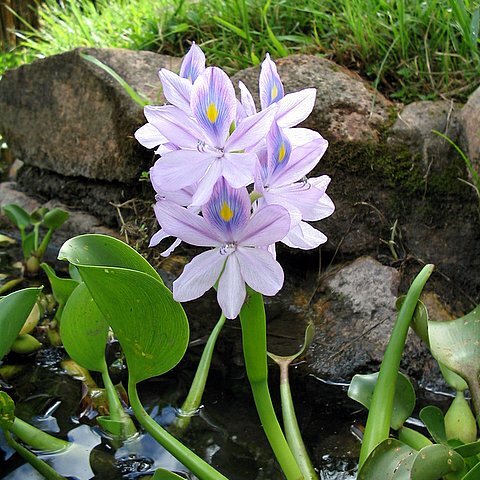Herbs, annual or perennial, aquatic, rooted in mud or free-floating. Stems of 2 types, vegetative and flowering; vegetative stems indeterminate, bearing many leaves, glabrous; flowering stems determinate, usually emersed, bearing single leaf, spathe, and terminal inflorescence. Leaves of 2 types, sessile and petiolate; stipule marcescent, apex truncate, associated with petiolate leaves only; sessile leaves submersed or rarely emersed, forming basal rosette or alternate on elongate stem, blade linear to occasionally oblanceolate, base sheathing, margins entire; petiolate leaves floating or emersed, blade cordate, reniform, or ovate. Inflorescences paniculate, spicate, umbellate, or 1-flowered; spathes bractlike, folded or clasping, commonly with acute to caudate extension. Flowers sessile, 3-merous; perianth with tepals connate proximally, yellow, blue, mauve, or white, tube tubular or funnelform, limb 6-lobed; stamens 3 or 6, adnate to perianth; pistils 3-locular, 1 or 3 developing to maturity; placentation parietal or basal; ovules 1–many. Fruits capsular or utriculate. Seeds smooth or with longitudinal wings.
Perennial aquatic herbs, emergent or (not in Australia) submerged. Stems stoloniferous, rhizomatous or erect. Leaves several at base and 1 on flowering stem, petiolate, sheathed; lamina entire, finely curvinerved, expanded or (not in Australia) linear. Inflorescence an erect spike, spike-like panicle or raceme arising from a sheath-like bract above the cauline leaf or (not in Australia) flowers solitary or paired. Flowers bisexual, homo-or hetero-stylous. Perianth 6-lobed or (not in Australia) 3-or 4-lobed, blue to purple, rarely white, or (not in Australia) yellow; lobes almost free or united into a basal tube. Stamens 6, or (not in Australia) 3 or 1, free or partly connate, inserted on perianth tube; anthers bilocular, basifixed with terminal pores or dorsifixed with longitudinal slits. Ovary superior, unilocular with 1 pendulous ovule or 3-locular with many ovules and axile placentation; ovules anatropous; style simple, upcurved; stigma terminal, 3-lobed. Fruit a nutlet or capsule. Seeds longitudinally ridged; embryo straight; endosperm copious.
Erect or floating aquatic herbs. Leaves with floating and/or emersed blades, sheathing at the base. Flowers hermaphrodite, regular or slightly irregularly two-lipped, arranged in racemes, spikes, panicles or sub-umbellate inflorescences subtended by a spathe-like leaf-sheath or solitary (Eichhornia). Perianth hypogynous, petaloid, divided into 6 lobes more or less arranged in two series, united at the base or free. Stamens 1, 3, or 6, equal or unequal, inserted on the perianth; filaments free; anthers dithecous, opening by longitudinal slits or rarely by terminal pores. Ovary superior, 3-locular with axile placentas or unilocular with 3 parietal placentas; style entire or lobed; ovules anatropous, numerous to solitary. Fruit a capsule opening by 3 valves, or an indehiscent achene. Seeds longitudinally ribbed, with copious endosperm
Stamens 6 or 3, rarely 1, inserted on the perianth, sometimes somewhat unequal in length or 1 the longest of all; filaments free; anthers 2-locular, opening lengthwise by slits or rarely by pores
Flowers bisexual, actinomorphic, arranged in racemes or panicles subtended by a spathe-like leaf-sheath; bracts minute or absent
Ovary superior, 3-locular, with axile placentas or 1-locular with 3 parietal placentas; style entire or shortly lobed
Leaves with floating or immersed blades sheathing at the base
Perianth hypogynous, corolline; lobes 6 or 4, sub-biseriate
Fruit a capsule opening by 3 valves, or indehiscent
Ovules numerous to solitary and then pendulous
Seeds ribbed, with copious endosperm
Aquatic erect or floating herbs

